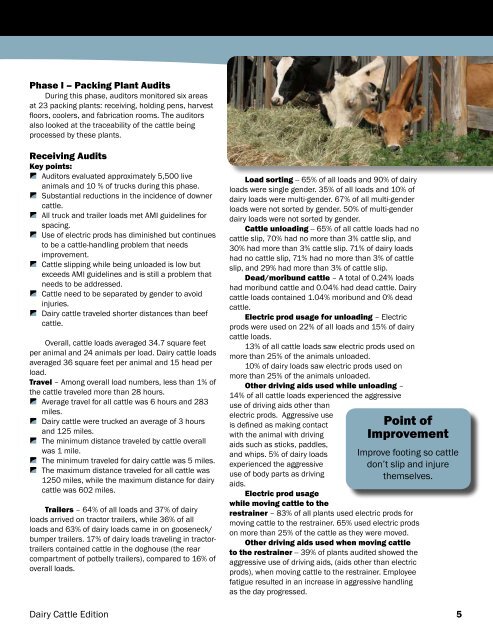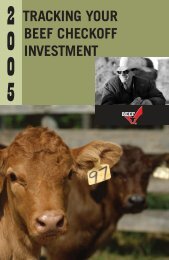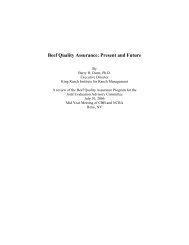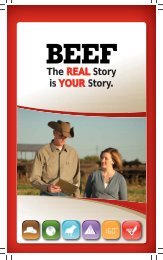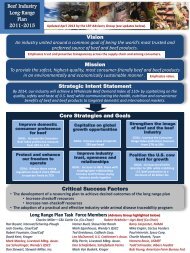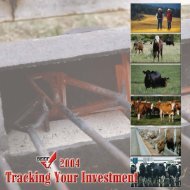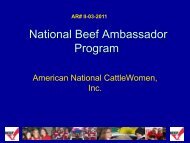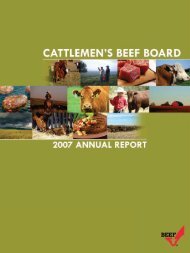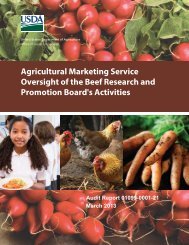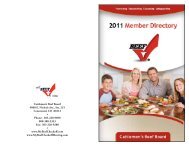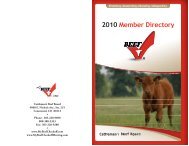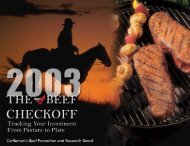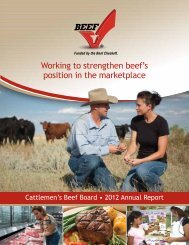National Market Cow and Bull Beef Quality Audit - Dairy Cattle Edition
National Market Cow and Bull Beef Quality Audit - Dairy Cattle Edition
National Market Cow and Bull Beef Quality Audit - Dairy Cattle Edition
- No tags were found...
Create successful ePaper yourself
Turn your PDF publications into a flip-book with our unique Google optimized e-Paper software.
Phase I – Packing Plant <strong>Audit</strong>sDuring this phase, auditors monitored six areasat 23 packing plants: receiving, holding pens, harvestfloors, coolers, <strong>and</strong> fabrication rooms. The auditorsalso looked at the traceability of the cattle beingprocessed by these plants.Receiving <strong>Audit</strong>sKey points:<strong>Audit</strong>ors evaluated approximately 5,500 liveanimals <strong>and</strong> 10 % of trucks during this phase.Substantial reductions in the incidence of downercattle.All truck <strong>and</strong> trailer loads met AMI guidelines forspacing.Use of electric prods has diminished but continuesto be a cattle-h<strong>and</strong>ling problem that needsimprovement.<strong>Cattle</strong> slipping while being unloaded is low butexceeds AMI guidelines <strong>and</strong> is still a problem thatneeds to be addressed.<strong>Cattle</strong> need to be separated by gender to avoidinjuries.<strong>Dairy</strong> cattle traveled shorter distances than beefcattle.Overall, cattle loads averaged 34.7 square feetper animal <strong>and</strong> 24 animals per load. <strong>Dairy</strong> cattle loadsaveraged 36 square feet per animal <strong>and</strong> 15 head perload.Travel – Among overall load numbers, less than 1% ofthe cattle traveled more than 28 hours.Average travel for all cattle was 6 hours <strong>and</strong> 283miles.<strong>Dairy</strong> cattle were trucked an average of 3 hours<strong>and</strong> 125 miles.The minimum distance traveled by cattle overallwas 1 mile.The minimum traveled for dairy cattle was 5 miles.The maximum distance traveled for all cattle was1250 miles, while the maximum distance for dairycattle was 602 miles.Trailers – 64% of all loads <strong>and</strong> 37% of dairyloads arrived on tractor trailers, while 36% of allloads <strong>and</strong> 63% of dairy loads came in on gooseneck/bumper trailers. 17% of dairy loads traveling in tractortrailerscontained cattle in the doghouse (the rearcompartment of potbelly trailers), compared to 16% ofoverall loads.Load sorting -- 65% of all loads <strong>and</strong> 90% of dairyloads were single gender. 35% of all loads <strong>and</strong> 10% ofdairy loads were multi-gender. 67% of all multi-genderloads were not sorted by gender. 50% of multi-genderdairy loads were not sorted by gender.<strong>Cattle</strong> unloading -- 65% of all cattle loads had nocattle slip, 70% had no more than 3% cattle slip, <strong>and</strong>30% had more than 3% cattle slip. 71% of dairy loadshad no cattle slip, 71% had no more than 3% of cattleslip, <strong>and</strong> 29% had more than 3% of cattle slip.Dead/moribund cattle – A total of 0.24% loadshad moribund cattle <strong>and</strong> 0.04% had dead cattle. <strong>Dairy</strong>cattle loads contained 1.04% moribund <strong>and</strong> 0% deadcattle.Electric prod usage for unloading – Electricprods were used on 22% of all loads <strong>and</strong> 15% of dairycattle loads.13% of all cattle loads saw electric prods used onmore than 25% of the animals unloaded.10% of dairy loads saw electric prods used onmore than 25% of the animals unloaded.Other driving aids used while unloading –14% of all cattle loads experienced the aggressiveuse of driving aids other thanelectric prods. Aggressive useis defined as making contactwith the animal with drivingaids such as sticks, paddles,<strong>and</strong> whips. 5% of dairy loadsexperienced the aggressiveuse of body parts as drivingaids.Electric prod usagewhile moving cattle to therestrainer – 83% of all plants used electric prods formoving cattle to the restrainer. 65% used electric prodson more than 25% of the cattle as they were moved.Other driving aids used when moving cattleto the restrainer -- 39% of plants audited showed theaggressive use of driving aids, (aids other than electricprods), when moving cattle to the restrainer. Employeefatigue resulted in an increase in aggressive h<strong>and</strong>lingas the day progressed.Point ofImprovementImprove footing so cattledon’t slip <strong>and</strong> injurethemselves.<strong>Dairy</strong> <strong>Cattle</strong> <strong>Edition</strong> 5


